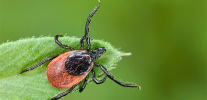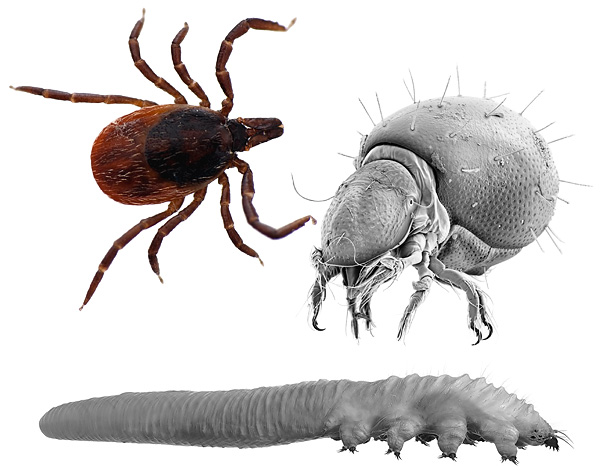
Few parasites can compete with ticks on the variety of the developed variants of parasitism. It is in the subclass of ticks that one can find examples of almost all forms of parasitism, which are known for arthropod invertebrates in general. In fact, by ticks, one can study parasitology in many of its classical manifestations.
And although it may seem that in this capacity, ticks are curious primarily for a natural scientist, but in fact for a person far from biological science, the parasitic lifestyle of ticks may be interesting - at least in its most original manifestations.
And many of the facts from the biology of these animals are remarkable in themselves.
Types of parasitism in ticks
The most well-known ticks for the average man are called Ixodes (they are often called forest ticks) - they represent only a very small group of the whole tick subclass.
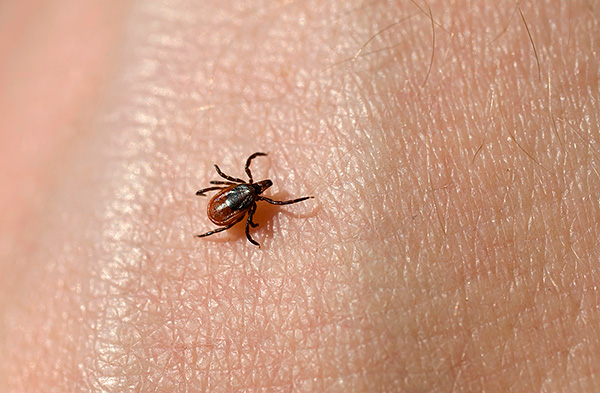
It is interesting
In total, more than 54,000 species of ticks are known today. The Ixodid family, some of which are carriers of tick-borne encephalitis and Lyme disease, includes only about 670 species — that is, slightly more than 1%.
The form of parasitism of Ixodes ticks can be characterized as obligate periodic ectoparasitism.
What does it mean?
Ectoparasites are living organisms that do not penetrate into the host’s body to feed on the host. As a rule, they have to damage the outer integuments of the host’s body in order to be able to eat certain tissues (in the case of ixodic ticks, blood), but they do not constantly live in the host’s body.
Unlike ectoparasites, endoparasites are those creatures that dwell within the body of the host.
Ixodic mites do not penetrate completely under the integuments of the body of a human or domestic animals, that is, they are typical ectoparasites.
In the same time, there are endoparasites among ticks. For example, scabies itch - the causative agent of scabies, better known as the subcutaneous mite - constantly dwells in the thicker skin, makes moves here and feeds on the epidermis.
The photo below shows what a subcutaneous mite looks like (Sarcoptes scabiei) under a microscope:
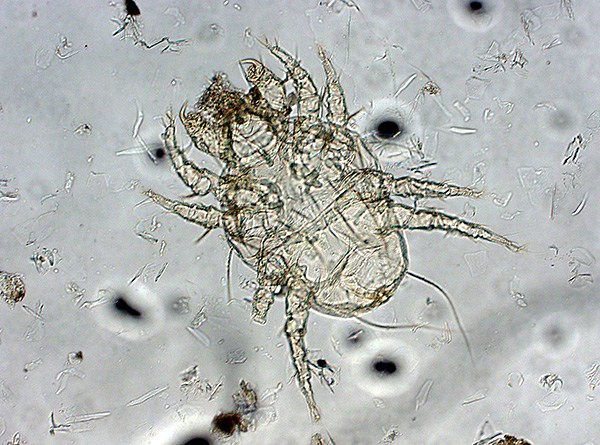
And here is a snapshot taken with a scanning electron microscope:
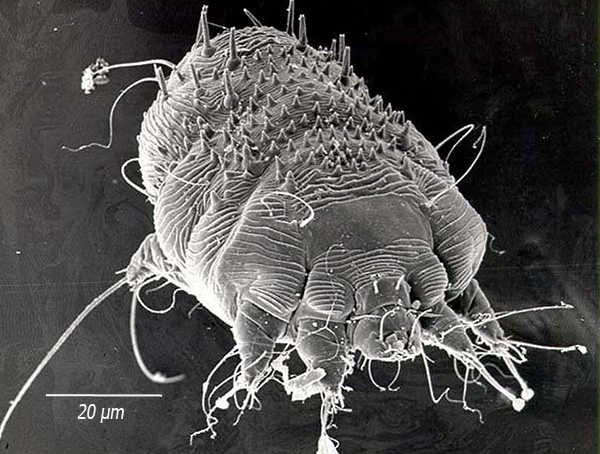
Similarly, acne - a very small representative of the order of trombidiform ticks that lives in the hair follicles of most people on the planet and eats sebum - is also an example of endoparasite. His relatives in the squad, by the way, are formidable parasites of cultivated plants.
Photo acne ironworks:

There are also cases of parasitism of ticks in the body cavities. For example, when a person eats infected products, cheese and flour mites can colonize the digestive tract: they can exist and even multiply here in conditions of an almost total lack of oxygen, causing severe gastrointestinal disorders.
It is interesting
In the scientific community among specialists there are disagreements over the extent to which the penetration into the body is to treat the parasite as internal, and at which degree - as external. So, there are points of view in which acne is attributed to ectoparasites, that is, to creatures living on the surface of the host's body.This point of view is justified by the fact that these mites are not introduced very deeply into the integuments of the body and live in the surface layer of the skin. Because of such disagreements, they even developed a system for classifying ticks on the cutaneous, percutaneous, subcutaneous, feather and abdominal ticks. Zheleznits most often refer specifically to percutaneous endoparasites.
Another sign by which the forms of parasitism are distinguished is the time spent on the surface or in the cavity of the host body. According to it, ticks are divided into permanent and temporary parasites.
Most ticks are typical temporary parasites that spend most of their life in the upper soil layer and on plants. They are taken to the surface of the host’s body only for food, and after saturation they leave it.

Opposite form - permanent parasites. Subcutaneous mites, iron ovaries, ear mites of the genus Otodectes, the entire life cycle of which passes on the surface or inside the integuments of the host’s body, can already be absolutely uniquely attributed to them. If it happens that the tick is outside the body of the owner, he immediately begins to search for a new one, without which he cannot survive.
Finally, tick parasitism can be obligate and optional.
Obligate parasitic mites are those that can only be fed by the host animal, otherwise they either die or cannot reproduce. They have no other way of feeding.
Optional parasites are living organisms that can combine different ways of obtaining food. Among ticks, such forms are presented, as a rule, by species that can combine predatory and parasitic types of food.
Such, for example, are many water mites, mites from the family Trombiculidae (rednecks). They have adults can attack small invertebrates and kill them, sucking the contents of the body. And the same individuals when meeting a large animal, which they are not able to kill, can climb on it, pierce the skin of his body and suck blood. That is, parasitism is not the only way for them to survive, and many of them never parasitize at all during their lifetime.
On a note
Approximately 48% of parasitic ticks are temporary parasites, 45% are permanent, the rest are random (optional).
Also, the already mentioned flour and cheese mites, which normally do not attack or parasitize a person, are considered optional parasites, but if they accidentally get into the digestive tract, they are established in it and become parasites.
Below in the photo is a cheese mite (Acarus siro), capable of causing intestinal acariasis:
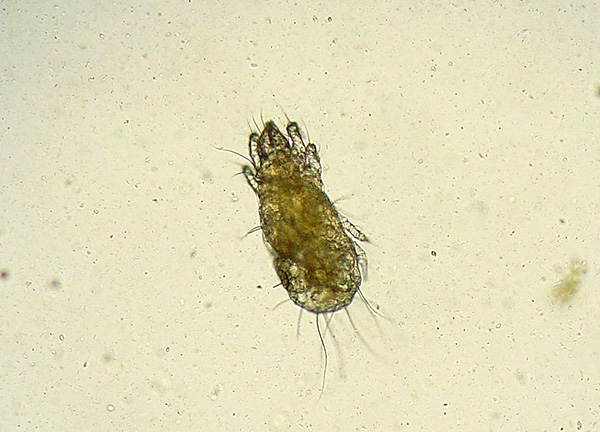
It is interesting that many species of ticks (there are many of them, for example, among red beasts) at the nymph stage are parasites, and turning into an adult state, they turn into predators. In such cases, however, it is impossible to talk about optional parasitism. Here we are talking about different ways of feeding at different stages of development: if the nymphs of such ticks are obligate parasites, then the adults are obligate predators.
The most famous ticks - Ixodes, Argas, and Subcutaneous - are obligate parasites and are not able to eat anything other than the biological materials of host animals.
On a note
It is noteworthy that there are fewer parasitic mites than predators and those that feed on various organic debris. For example, the whole family of granary ticks, which feed on grain and plant debris, is known. Dust mites that feed on pieces of the epidermis that fall off people’s bodies are very widespread in the apartments, and thousands of microscopically small representatives of this subclass living in the soil and consuming decaying plants and animals are described.
That is, in spite of the “image” of parasites formed by ticks, not all of them lead a parasitic lifestyle.
It is also known a huge number of species of mites, which are parasites of plants - feeding on the sap of leaves and stems and harming agriculture.
Curious is the example of the above-mentioned ironworks. Their way of interacting with humans is not always typical parasitism, since in most cases a person does not suffer from their activity and does not feel the presence of these creatures on the skin or inside it at all. Given that iron women are found in almost all people over 70 years old and in more than half of adults around the world, cases of skin diseases caused by these ticks are rare.
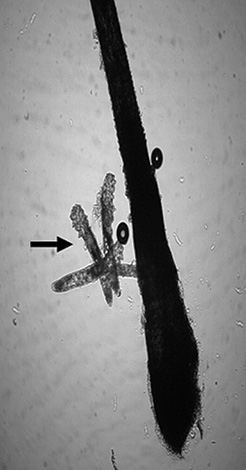
Consequently, most often people do not suffer from coexistence with these arthropods. In the absence of such antagonism, the interaction between the host and the “guest” is not called parasitism, but commensalism.
It is worth noting that acarologists do not have a unanimous opinion as to whether they are considered parasites or commensals. This is another example of the diversity of forms of interaction of ticks with their owners.
Single, two-house and three-house pincers
Important in parasitology is the classification of ticks by the number of hosts. In accordance with it, different types of ticks are divided depending on what minimum number of host animals one individual of a particular species must change in order to fully realize its reproductive cycle.
For example, all parasitic ticks can be divided according to this feature into three types:
- Single mites. They have a full development from the larva to the mature individual on the same host, without changing it. The larva sucks blood, sheds the nymph, feeds again, sheds into the imago, mates with an individual of the opposite sex, sucks blood again, after which the female leaves the host's body to lay eggs in the soil or in other places. Such species include, for example, the bovine mite and the species Hyalomma scupense - members of the family of ixodid ticks;
- Dwelling mites - those in which the larvae and nymphs feed on one host, after turning into a nymph and the next bloodsucking, leave his body, turn into imago, which then attacks the second host, sucks blood for fertilization, and then detaches to mate and (for females) lay eggs.This development cycle is characteristic of some species of the genera Hyalomma and Rhipicephalus;
- Trilatory mites are species in which an individual changes at each stage of development. This group includes the majority of representatives of the family of Ixodes ticks. In particular, taiga and dog ticks are three-farm.
In all these forms, the number of hosts is not identical to the concept of species specificity. That is, it would be a mistake to believe that all individuals of one or another type of single-holding tick can develop, for example, only on dogs, and individuals of a two-species type larval stage and nymph stage are carried out, for example, on rats, and in an adult form they attack only cows.
In fact, "economic" means only the number of shifts of owners during the life of one tick. Individuals of the same species of single-house ticks can develop on hedgehogs, on rodents, on hares, on dogs or on cattle. Where a particular parasite will grow depends only on which particular host animal it can attack.
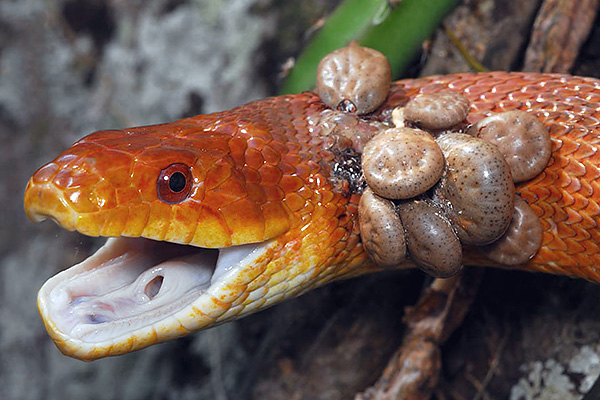

Virtually all types of ticks, replacing the owners, there is no strict species-specificity in relation to their "hosts".Even the names of ticks of the “dog” or “bull” type are not strict indications of the type of victim: many individuals of the dog tick successfully develop on cattle or hedgehogs, and the tick can safely suck blood from people, poultry, rats and the same dogs Very often, ixodic mites even attack cold-blooded animals - turtles, frogs, lizards and snakes.
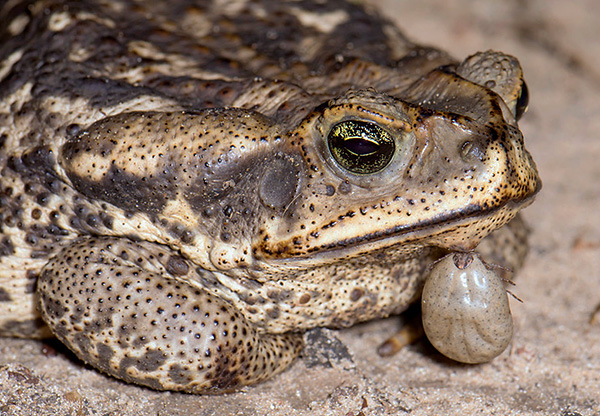
It is interesting
Many acarologists consider (and use) hedgehogs as a kind of “vacuum cleaner” for ticks in the wild. The fact is that the hedgehog is hard to care for the surface of its back and clean the parasites here, and therefore in late spring many individuals have their entire back literally stuck with ticks of different ages and degrees of fatness. There are cases when specialists collected a hedgehog to collect ticks in natural stations, took parasites off of it, then let them go and simply followed him in order not to lose sight of them, and every few hours they took him and removed new ticks. In the jargon, even the expression “hourly” appeared, meaning the number of ticks that a hedgehog can gather on itself in one hour of movement in the grass.
Some specificity may be associated with the structural features of the sense organs and the ecology of a particular type of tick. For example, an adult dog mite often lurks its prey sitting on grass stalks, and here it is more likely to “catch” a large animal, rather than a hedgehog or a lizard. And the nymphs of the taiga tick, on the contrary, in search of the victim more often climb into the holes and cavities under the stones, where they are most likely to encounter mice, voles or lizards.
On a note
In argas mites, even omovampirism is observed - a behavior in which a hungry individual attacks the well-fed, pierces the integuments of its body and sucks the blood from it, which was previously fed on the fellow-victim. Simply put, ticks do not care who to attack and suck their blood, but evolutionary adaptations contribute to the fact that each species has a certain specialization.
At the same time, the concept of "economy" is not relevant for endoparasite ticks. One cannot say, for example, that a scabies mite is a single-owner mite, although from a terminological point of view, this is true - the entire development of one individual takes place on the same host animal.The number of owners is spoken only for temporary parasites, who necessarily spend part of their life freely, without contact with the host's body.
Interesting facts about parasitic mites
The parasitic lifestyle has greatly influenced the biology of ticks. And in many cases, these features have become so unique that they have become real phenomena.
Like most other free-living ectoparasites, ticks can go hungry for a long time. This is a necessary guarantee of their survival, given that the trapping type of hunting for the host requires a long wait. Thus, the usual Ixodes mites of the genus Hyalomma can go hungry up to 10-12 months, and adults of some other species - up to 2-3 years.
Hyalomma marginatum:
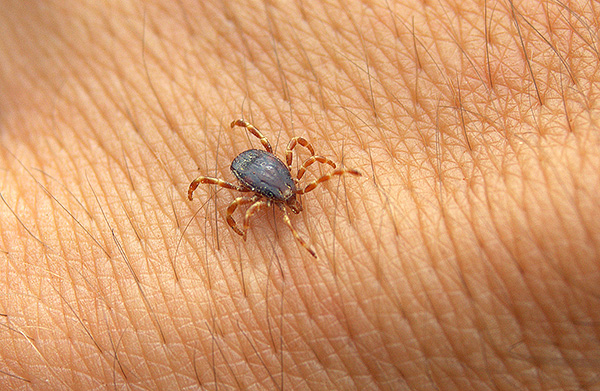
Some ticks that parasitize birds live in a nest litter in bird colonies and feed when the bird sits on the nest, and most actively reproduce when chicks appear. That parasites often cause zamora chicks, literally biting them to death.
On a note
The entire period for which birds fly south or (for Antarctic species) north, these ticks go hungry and wait for the owners to return, and such a hunger strike for 8–9 months a year is a normal part of their life cycle.It is precisely due to such adaptations to the life cycle of the host that the mites were able to spread, including on the rocky Arctic and Antarctic islands, where there are practically no other arthropods.
For 9-10 months a year, under a layer of snow and ice, the nymphs and adults of these species are in a state close to anabiosis - to wait for the arrival of spring, to move to the nest and re-fill with blood.
As with any other parasite, high mortality is characteristic of ticks. Less than 1% of individuals hatched from eggs live to adulthood, with a huge number of eggs being destroyed by predators and superparasites (for example, by some equestrians). However, ticks have managed to adapt to this, multiplying in enormous quantities.
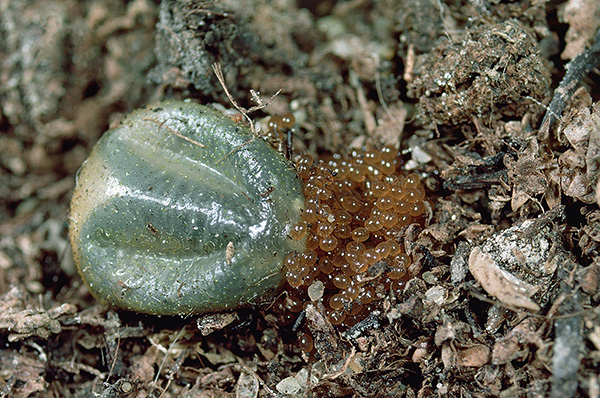
Ticks are also distinguished by the highest prevalence and breadth of the host animal spectrum. They can parasitize (and parasitize) almost all mammals and birds, reptiles and amphibians, and aquatic mites can attack fish. Even terrestrial species normally tolerate prolonged immersion under water and do not die for several hours under water while the blood of the victim sucks at this time.This allows them to parasitize animals that lead a semi-aquatic lifestyle.
Finally, poisonous mites are known. Most of them are among the argas mites, whose saliva is so toxic that it can cause severe pain at the site of the bite, anaphylaxis and even muscle paralysis. In particular, bird ticks of the species Ornithodorus coriaceus in the southern United States and in Mexico are considered more dangerous than rattlesnakes, precisely because of the pain of their bites.
How they became parasites: hypotheses about the evolution of parasitism
Most of the theories about the development of parasitism in ticks are hypotheses with varying degrees of reliability, however, some of these hypotheses for different species have the greatest number of evidence, and therefore are considered basic.
In particular, the parasitism of ixodid ticks is most likely a consequence of the predation of their ancestors. It is known that ticks are representatives of the arachnid class, and there is reason to believe that it was the ancient spiders who were the ancestors of modern ticks, and not vice versa.
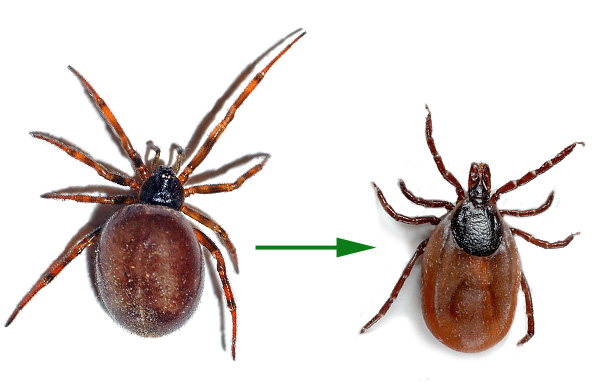
Most spiders are predators, feeding on the fact that they catch prey, inject saliva with digestive enzymes into the cavity of her body, and then suck the resulting “broth”, leaving the integument intact.
Perhaps some ancient spiders and mites attacked their victims and began to devour them before the victim died. Examples of such hunting are known among modern species. Some of these ticks could go on the attack on larger victims who were not required to kill. For this, only the ability to suck blood or lymph was necessary, without causing acute pain in the host, and gradually it developed in an evolutionary way - those individuals survived whose saliva caused the least irritation in the host until parasites appeared that bit completely painless. They became the first obligate parasitic mites.
On a note
Fossil mites are also known from the Devonian when vertebrate animals did not even begin to conquer the land. There is an assumption that the already rather isolated morphologically species sucked the blood of dinosaurs.
Further evolution took place, most likely, in the direction of strengthening the ties between the mites and their owners. Trilogan mites, apparently, are the most ancient and least specialized, two-owner mites have already taken the first step in rapprochement with the owner. The top of this path are endoparasite mites - itching,zheleznitsy and the like, who are completely “related” with their victims and thus received constant food and “shelter”. By the way, they adapted to feeding with those tissues that are not critical for the survival of the host.
Most likely iron ores are younger species than pruritus. It is known that the host-parasite relationship is constantly evolving to reduce antagonism.. This reduces the mortality of the host from the activity of parasites and increases the chances of survival of the parasites themselves, depending on the host. Plus, in the absence of anxiety on the part of the parasite, the owner takes no measures to combat it. It was the ironworks that reached the evolutionary level, the activity of which the human body practically does not suffer at all.
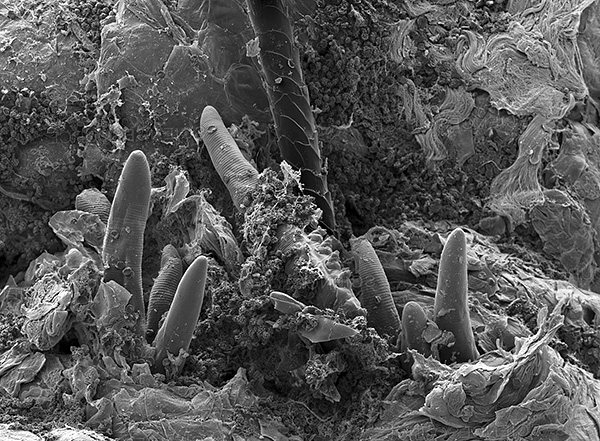
At present, it is not known how dust mites evolved - whether they switched from feeding the epidermis directly on a person to feeding on exfoliated epidermis in room dust, or initially feeding all organic debris into a person’s dwelling, and then narrowing down the ration only to peeling skin residue. To clarify this issue requires additional research on the anatomy and biology of these arthropods.
Adaptations to the parasitic lifestyle
Together with the basic abilities and functions, ticks have developed numerous additional adaptations necessary for the parasitic lifestyle.
This primarily relates to the device of the oral apparatus. The jaws of the ticks have become a highly effective piercing tool that, after punctured the skin and walls of the blood vessel, expands in such a way that it keeps the parasite on the host’s body and not only prevents it from falling accidentally, but also prevents any attempts to intentionally remove it with a lot of effort. Simply put, due to the special teeth of the tick, it is difficult to tear off the skin.
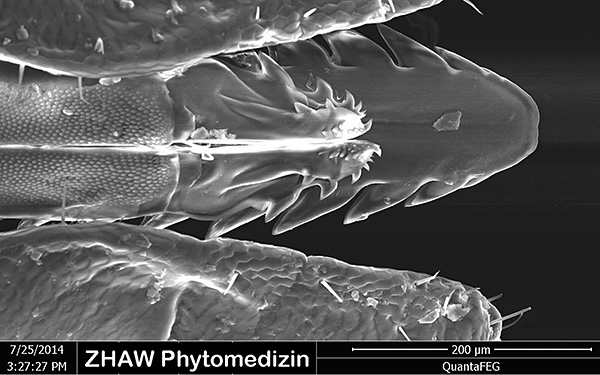
Other specific features of ticks, like parasites, include the following devices:
- Colossal stretchability of the digestive tract and cuticle. An adult female can deposit in herself several times more blood than she weighs. When bloodsucking, its size increases more than 10 times, and the body turns from almost flat before feeding to almost round - after it. This ability allows you to maximize the use of the possibility of feeding on one host;
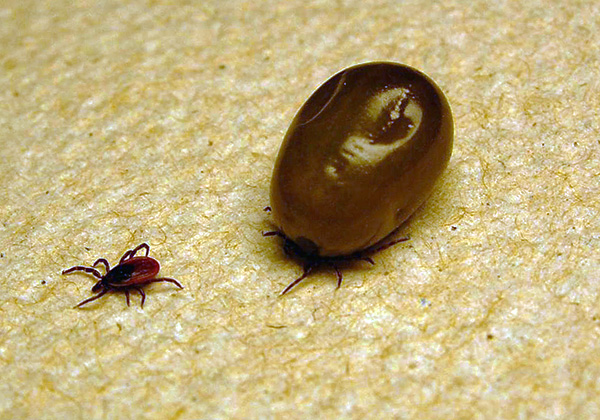
- The presence of anticoagulants of blood and local anesthetics in the saliva. The former prevent thickening of the blood and facilitate its absorption, the latter make the bite invisible to the host;
- The already mentioned ability for a long fast;
- Huge fecundity. By the number of eggs laid, mites are champions among bloodsucking arthropods. The females of large Ixodes ticks lay up to 20,000 eggs in their lifetime, and the females of small species that live in the burrows of their owners lay about 1 thousand eggs. Such fecundity ensures that even with low survival, part of the offspring still live to reproductive age and also take part in reproduction;
- Adaptation to the biology of the host species - the phenology of reproduction, lifestyle, features of anatomy.
In general, the influence of the parasitic lifestyle on the biology of ticks is very large and contributes to the increasing specialization of these arthropods.
Diseases of humans and animals associated with tick parasitism
Various diseases associated with the attack of ticks on humans and animals can be considered a kind of side effect of the activity of these parasites.The fact is that the evolutionary grave consequences of a parasite attack on the host reduce the likelihood of the survival of both participants in such a relationship, and therefore are not “beneficial” for anyone.
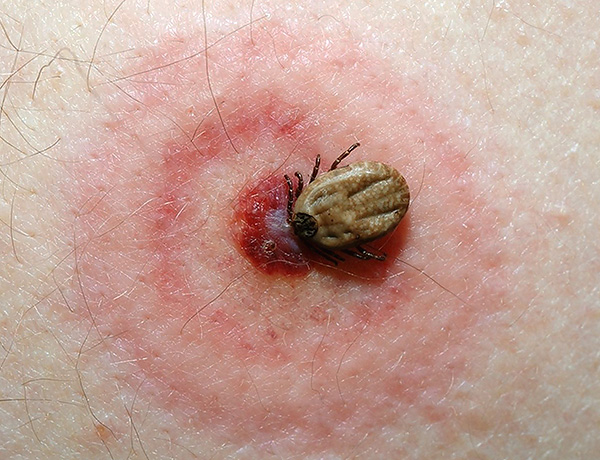
However, such diseases are widespread and pose a danger to both humans and animals. They are called acariasis, and the following are of the greatest medical importance:
- Scabies that develop when the female scabies itch layer of the epidermis is permanently damaged. May cause severe skin lesions and associated conditions;
- Tick-borne encephalitis is a viral disease, deadly, it still takes hundreds of lives each year. It is fraught with disability even with effective treatment;
- Lyme disease (Lyme borreliosis) is a deadly bacterial disease, the carrier of which develops in the body of the tick and is transmitted to humans through bloodsucking;
- Tick-borne paralysis - occurs due to the action of toxins contained in the saliva of some ticks on the skeletal muscles of the human body. Mortality among the sick - 10-12%, mostly children are ill;
- Intestinal acariasiscaused by ingestion of cheese and some other ticks and their transition to existence and even reproduction in anaerobic conditions with damage to the epithelial lining of the intestinal tract;
- Various dermatitis, also called acarodermatitis;
- Alopecia in animals and loss of plumage in birds. Abundant reproduction of some argas mites in poultry houses sometimes causes poultry to freeze;
- Allergic reactions (up to anaphylactic shock);
- Demodecosis, rosacea and rosacea, caused by the reproduction of iron ores in very large quantities This leads to inflammation of the hair follicles, redness of the skin, dilation of blood vessels, itching.
Most of these diseases are characteristic of both people and animals. For example, a huge number of skin and trichological diseases of cattle, cats and dogs, pigeons, chickens and rabbits are caused by parasitic mites.
Subcutaneous mite Demodex (iron): video taken under a microscope
Removing scabies itch from under the skin (Sarcoptes scabiei)

